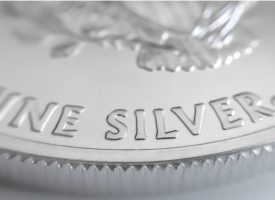This is what the gold market is watching, look at these real (negative) central bank rates, plus some stunning charts.
Gold
June 9 (King World News) – Ole Hansen, Head of Commodity Strategy at Saxo Bank: Gold is ticking higher but struggling to get excited by the continued drop in US Treasury yields primarily being led by lower inflation expectations (breakevens)…
Gold Market Watching Real Yields
Real (Negative) Central Bank Rates!
Charlie Bilello: Real Central Bank Rates (rate minus inflation)…
Poland: -4.7%
Brazil: -4.6%
Saudi Arabia: -4.3%
US: -4.1%
Canada: -3.2%
Chile: -3.1% =
Norway: -3.0% =
Malaysia: -3.0% =
Philippines: -2.5%
Eurozone: -2.5%
S. Korea: -2.1%
Mexico: -1.9%
UK: -1.4%
Swiss: -1.4%
Russia: -1.0%
India: -0.3%
ALERT:
Legendary investors are buying share of a company very few people know about. To find out which company CLICK HERE OR ON THE IMAGE BELOW.
 Sponsored
Sponsored
Some Stunning Charts Below
The Q Ratio and Market Valuation
Jill Mislinski: The Q Ratio is a popular method of estimating the fair value of the stock market developed by Nobel Laureate James Tobin. It’s a fairly simple concept, but laborious to calculate. The Q Ratio is the total price of the market divided by the replacement cost of all its companies. Fortunately, the government does the work of accumulating the data for the calculation. The numbers are supplied in the Federal Reserve Z.1 Financial Accounts of the United States, which is released quarterly.
The Q2 2019 release had significant revisions. Here is an explanation from the Fed:
“The upward revision to liabilities on the corporate balance sheet brings the U.S. Financial Accounts into closer alignment with the international standards in the System of National Accounts 2008. Because the revised measure of liabilities represents a broader definition than is typically assumed on corporate balance sheets, we have adjusted the debt- and equity-to-net worth ratios shown on table B.103 (lines 43 and 45) to exclude the equity portion of FDI.”
You can read more regarding these revisions here by clicking on “Why did the net worth of the nonfinancial corporate business sector revise significantly downward with the 2019:Q2 publication?”
Extrapolating Q
The ratio subsequent to the latest Z.1 Fed data (through 2020 Q3) is based on a subjective process that factors in the monthly closes for the Vanguard Total Market ETF (VTI).
Unfortunately, the Q Ratio isn’t a very timely metric. The Z.1 data is over two months old when it’s released, and three additional months will pass before the next release. To address this problem, our monthly updates include an estimate for the more recent months based on changes in the VTI price (the Vanguard Total Market ETF) as a surrogate for Corporate Equities; Liability.
The first chart shows the Q Ratio from 1900 to the present.
Interpreting the Ratio
The data since 1945 is a simple calculation using data from the Federal Reserve Z.1 Statistical Release, section B.103, Balance Sheet and Reconciliation Tables for Nonfinancial Corporate Business. Specifically, it is the ratio of Market Value divided by Replacement Cost. It might seem logical that fair value would be a 1:1 ratio. But that has not historically been the case. The explanation, according to Smithers & Co. (more about them later) is that “the replacement cost of company assets is overstated. This is because the long-term real return on corporate equity, according to the published data, is only 4.8%, while the long-term real return to investors is around 6.0%. Over the long-term and in equilibrium, the two must be the same.”
The average (arithmetic mean) Q Ratio is about 0.79. The chart below shows the Q Ratio relative to its arithmetic mean of 1 (i.e., divided the ratio data points by the average). This gives a more intuitive sense to the numbers. For example, the all-time Q Ratio high at the peak of the Tech Bubble was 2.17 — which suggests that the market price was 174% above the historic average of replacement cost. The all-time lows in 1921, 1932 and 1982 were around 0.28, which is approximately 62% below replacement cost. That’s quite a range. The latest data point is 272% above the mean. Remember, this is extrapolated using the monthly VTI close and the most recent Q Ratio – which is 2.64 as of Q3 2020.
Another Means to an End
Smithers & Co., an investment firm in London, incorporates the Q Ratio in their analysis. In fact, CEO Andrew Smithers and economist Stephen Wright of the University of London co-authored a book on the Q Ratio, Valuing Wall Street. They prefer the geometric mean for standardizing the ratio, which has the effect of weighting the numbers toward the mean. The chart below is adjusted to the geometric mean, which, based on the same data as the two charts above, is 322%.
The Message of Q: Overvaluation
Of course, periods of over-and under-valuation can last for many years at a time, so the Q Ratio is not a useful indicator for short-term investment timelines. This metric is more appropriate for formulating expectations for long-term market performance. As we can see in the next chart, peaks in the Q Ratio are correlated with secular market tops – the Tech Bubble peak and current market values being extreme outliers.
One Of The Largest Silver Discoveries In History
Listen to this 7 minute audio interview to learn about a company that just started trading today that is looking to make one of the largest silver discoveries in history with surface samples as high as a staggering 300,000 grams of silver! CLICK HERE TO FIND OUT MORE.
Also just released: All Roads Now Lead To Gold! CLICK HERE.
Also just released: Gold Correction Shallow, Household Debt And Incomes, Commodities, US Dollar Shorts, And Timber! CLICK HERE.
Also just released: Look At What Just Hit The Highest Level Since 1981! CLICK HERE.
Also just released: A Number Of Things Now Coming Together That Will Push Gold Prices Even Higher CLICK HERE.
Also just released: WARNING: Shortages To Continue Into 2023, Plus An Email From A KWN Reader CLICK HERE.
Also just released: SPROTT: Strong Tailwinds Are Supporting The Gold Bull Market CLICK HERE.
Also just released: Ted Oakley – To Invest In The Coming Inflation You Have To Make Dramatic Shifts CLICK HERE.
***To listen to one of the great veterans in the business discuss gold, silver, how to invest in the coming inflation, and much more CLICK HERE OR ON THE IMAGE BELOW.
***To hear Alasdair Macleod discuss the impact of the coming Basel III regulations on bullion banks and what the banks are up to right now CLICK HERE OR ON THE IMAGE BELOW.
© 2021 by King World News®. All Rights Reserved. This material may not be published, broadcast, rewritten, or redistributed. However, linking directly to the articles is permitted and encouraged.














